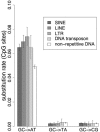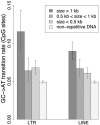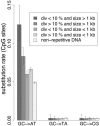Homology-dependent methylation in primate repetitive DNA
- PMID: 15797989
- PMCID: PMC556223
- DOI: 10.1073/pnas.0408986102
Homology-dependent methylation in primate repetitive DNA
Abstract
In mammals, several studies have suggested that levels of methylation are higher in repetitive DNA than in nonrepetitive DNA, possibly reflecting a genome-wide defense mechanism against deleterious effects associated with transposable elements (TEs). To analyze the determinants of methylation patterns in primate repetitive DNA, we took advantage of the fact that the methylation rate in the germ line is reflected by the transition rate at CpG sites. We assessed the variability of CpG substitution rates in nonrepetitive DNA and in various TE and retropseudogene families. We show that, unlike other substitution rates, the rate of transition at CpG sites is significantly (37%) higher in repetitive DNA than in nonrepetitive DNA. Moreover, this rate of CpG transition varies according to the number of repeats, their length, and their level of divergence from the ancestral sequence (up to 2.7 times higher in long, lowly divergent TEs compared with unique sequences). This observation strongly suggests the existence of a homology-dependent methylation (HDM) mechanism in mammalian genomes. We propose that HDM is a direct consequence of interfering RNA-induced transcriptional gene silencing.
Figures






Similar articles
-
Determining the global DNA methylation status of rat according to the identifier repetitive elements.Electrophoresis. 2007 Nov;28(21):3854-61. doi: 10.1002/elps.200600733. Electrophoresis. 2007. PMID: 17960839
-
From the margins of the genome: mobile elements shape primate evolution.Bioessays. 2005 Aug;27(8):785-94. doi: 10.1002/bies.20268. Bioessays. 2005. PMID: 16015599 Review.
-
Germline methylation patterns inferred from local nucleotide frequency of repetitive sequences in the human genome.Mamm Genome. 2007 Apr;18(4):277-85. doi: 10.1007/s00335-007-9016-6. Epub 2007 May 19. Mamm Genome. 2007. PMID: 17514347
-
The rate of CpG mutation in Alu repetitive elements within the p53 tumor suppressor gene in the primate germline.J Mol Biol. 1996 May 3;258(2):240-50. doi: 10.1006/jmbi.1996.0246. J Mol Biol. 1996. PMID: 8627622
-
Functions of DNA methylation: islands, start sites, gene bodies and beyond.Nat Rev Genet. 2012 May 29;13(7):484-92. doi: 10.1038/nrg3230. Nat Rev Genet. 2012. PMID: 22641018 Review.
Cited by
-
Reduced chromatin accessibility underlies gene expression differences in homologous chromosome arms of diploid Aegilops tauschii and hexaploid wheat.Gigascience. 2020 Jun 1;9(6):giaa070. doi: 10.1093/gigascience/giaa070. Gigascience. 2020. PMID: 32562491 Free PMC article.
-
Gene function and expression level influence the insertion/fixation dynamics of distinct transposon families in mammalian introns.Genome Biol. 2006;7(12):R120. doi: 10.1186/gb-2006-7-12-r120. Genome Biol. 2006. PMID: 17181857 Free PMC article.
-
Does selection against transcriptional interference shape retroelement-free regions in mammalian genomes?PLoS One. 2008;3(11):e3760. doi: 10.1371/journal.pone.0003760. Epub 2008 Nov 19. PLoS One. 2008. PMID: 19018283 Free PMC article.
-
Small RNAs, DNA methylation and transposable elements in wheat.BMC Genomics. 2010 Jun 29;11:408. doi: 10.1186/1471-2164-11-408. BMC Genomics. 2010. PMID: 20584339 Free PMC article.
-
Epigenetic QTL mapping in Brassica napus.Genetics. 2011 Nov;189(3):1093-102. doi: 10.1534/genetics.111.131615. Epub 2011 Sep 2. Genetics. 2011. PMID: 21890742 Free PMC article.
References
-
- Yoder, J. A., Walsh, C. P., Bestor, T. H., Woodcock, D. M., Lawler, C. B., Linsenmeyer, M. E., Doherty, J. P. & Warren, W. D. (1997) Trends Genet. 13, 335–340. - PubMed
-
- Selker, E. U., Cambareri, E. B., Jensen, B. C. & Haack, K. R. (1987) Cell 51, 741–752. - PubMed
-
- Selker, E. U. (2002) Adv. Genet. 46, 439–450. - PubMed
-
- Selker, E. U., Tountas, N. A., Cross, S. H., Margolin, B. S., Murphy, J. G., Bird, A. P. & Freitag, M. (2003) Nature 422, 893–897. - PubMed
-
- Selker, E. U. (1990) Annu. Rev. Genet. 24, 579–613. - PubMed
Publication types
MeSH terms
Substances
LinkOut - more resources
Full Text Sources
Other Literature Sources

